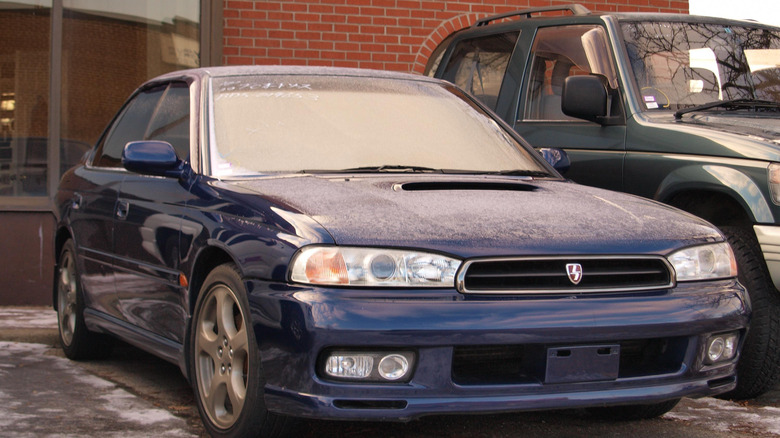This Subaru Had One Of The Only Twin-Turbo Flat-Four Engines Ever Made Under The Hood
Subaru and flat, or "boxer" engines are practically synonymous with one another. Beyond the Japanese automaker and Porsche, no other major manufacturer regularly utilizes flat engine configurations these days — and certainly not across their entire model range like Subaru does. Of course, many automakers besides these two have historically dabbled in flat configurations, but only Subaru ever really ran with it. From the iconic rumble given off by unequal headers to its infamously tedious spark plug changes, the Subaru boxer has rightfully earned its place as a capable and characterful engine, particularly when turbocharged.
Most of the time, you'll find Subaru boxers in one of two configurations: naturally-aspirated or turbo, with other discrepancies between each family like cylinder count, power figures, and so on. There are a lot of applications for a boxer, be it your standard boring crossover up to dominant rally monsters; it's the latter we'll be focusing on here, because it's a little-known fact that Subaru once fit two turbochargers to a single boxer, and the company did it in the name of speed.
The engine in question is the EJ20, a classic, simple powerplant that came in multiple flavors depending on model and trim. But for a brief timeframe, and never in North America, you could pick up certain versions of the 1990s Subaru Legacy and look under the hood to find a factory twin-turbo. Or, more accurately, a two-stage turbo system, as it was commonly known. There's a reason behind that choice of words, because this system utilized a sequential turbocharger system, a common setup for many legendary JDM cars. Let's dive in and discuss this engine's unique history and how it works.
The EJ20's sequential twin-turbo setup
The sequential twin-turbo EJ20H, as it's known, debuted in 1993 on non-USDM Subaru Legacy models in the GT and GT-B trim. It produced a total of 250 ps, or about 247 hp, at 6,500 rpm in its early configuration, though minor variations exist that improved power slightly. Only right-hand drive models were ever equipped with the EJ20H; while no publicly official documentation from Subaru exists as to why, it's likely due to fitment issues created from shoving a left-hand drive steering rack in with a twin-turbo setup.
History aside, how does this setup differ from a single turbo, and what was the point of it? In short, it's to do with the engine's power band. Back in the 1980s, turbocharging wasn't nearly as refined as today; factors like turbo lag were commonplace, leading to cars like the Porsche 930 Turbo earning the moniker "Widowmaker." Multiple manufacturers tried different methods to solve this problem; Subaru, along with other JDM automakers like Toyota and Nissan, all opted for sequential turbocharging.
A sequential turbo setup involves mating two turbochargers together in such a way that one turbocharger is active at low revs, before both activate at higher rpms, thus minimizing turbo lag. A single turbocharger, by contrast, needs time to spool up; the larger the turbo, the longer it'll take and the more lag you'll have. So you use a small turbo to provide a boost in the lower bands to prevent the engine from bogging down at low revs before the turbo has a chance to kick in.
Why Subaru used (and discontinued) the EJ20H
Subaru has a long and storied history in rally, and that readily bled over to its passenger cars throughout the 1980s up to the present day — hence why we have "WRX" badges and the blue with brass rims and so on. This all began with the 1990 Legacy RS, one of the earliest truly iconic competitors on the global rally stage. We don't know why Subaru decided to fit a sequential turbo into the Legacy come 1993, but considering its rally pedigree, it was most likely a performance trim offered to build on that heritage.
However, the two turbos came with downsides. Aside from creating a more cramped and complicated power plant, the turbos' extra power wasn't entirely predictable, despite the theoretical benefits. That's because there was a gap in the turbo response; the engine had impressive low-end grunt, but then had a mid-rpm lull before picking up again when the second turbo activated.
The sequential turbo was fitted to reduce turbo lag, but that's also likely why Subaru dropped it as well: Turbocharger technology has come a long way since the early 1990s, and modern turbochargers feature remarkably little, if any, discernible turbo lag. The EJ20 engine was also aging and eventually discontinued because it didn't meet the tightening domestic emissions restrictions. Therefore, while the sequential turbo Legacy was a funky novelty, it was also a product of its time, and that time has passed.


